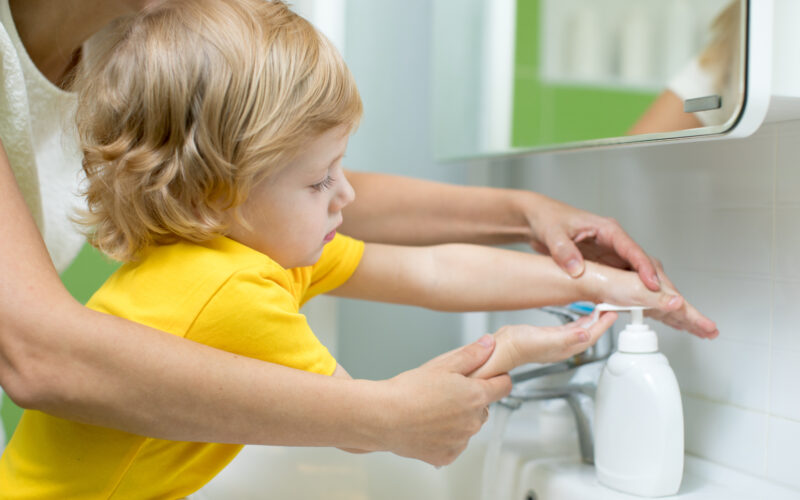If it seems as if your kids are always picking up germs and getting sick, it’s not your imagination. With developing immune systems, packed classrooms and a tendency to taste and touch with abandon, kids are much more likely than adults to catch and spread germs, says Dr. William Sears, a pediatrician and associate clinical professor of pediatrics at the University of California, Irvine.
But you can teach kids habits to help them avoid and contain germs so they — and the rest of your family — stay healthy. And the earlier you start, the better, says Betsy Brown Braun, a parenting expert and author of Just Tell Me What to Say. Try these tricks for teaching little ones to stay germ-free. With practice, the habits will become as ingrained as saying please and thank you.
1. Lead by example.
The most important habit to teach kids: Wash hands often. Wash them before eating, after returning home, after using the bathroom or blowing their nose. And if they accidentally cough or sneeze into their hands (instead of into their sleeve), teach them to wash hands right away.
As you might expect, the best way to drive home the message is by demonstrating these good habits yourself. Wash your hands at these times too — every time.
“The magic is modeling the behavior,” says Dr. John Mayer, a clinical psychologist and author of Family Fit. Children learn more by watching than any other way.
Accompany your behavior with a verbal cue: “We wash our hands every time after using the bathroom” or “We wash our hands every time before we eat.” Kids will start remembering even when you’re not around.
2. Sing a song.
Getting kids to wash their hands for a full 20 seconds is just as important as having them wash in the first place. “Kids usually stick their hands under water for a split second, which doesn’t kill any germs,” says Mayer. But give them a fun way to measure time, and they’ll stick it out longer.
Singing the happy birthday song twice or saying the ABCs takes about 20 seconds. Practice with your child when washing hands together. Over time, your child will start singing and scrubbing to the end of the song on her own.
3. Play a game.
When kids cough or sneeze into the air, on their hands — or worse, on their friends — germs spread easily. To teach them to aim into their sleeve, create a game out of it.
“Tell them they have a ‘germ catcher’ in the crook of their arm, and when they aim there, they catch and trap the germs,” suggests Braun. It may take a little time but remind them about the game every time, and the habit will eventually stick.
4. Add a cool factor.
Since one of the ways germs are transmitted is through hand-to-hand contact, talk to your child about not giving high fives on the sports field. Instead, help him come up with a unique greeting he thinks is cool.
Mayer, for example, gives his patients a fist bump. When you pick up your child from practice, use his greeting to encourage its use. (Unless, of course, he’s at the age when everything mom does is just not cool.)
5. Use a visual aid.
It’s smart for your child to keep a distance from kids who are constantly coughing or wiping a runny nose, says Sears. Likewise, if your kid sees a pal sneeze or cough on a toy or a ball, he should choose a different object to play with.
Since kids tend to be visual learners, use a water-filled spray bottle to simulate how far coughs and sneezes can reach while explaining how germs are spread. “Tell them that everyone has water in their body that contains germs,” says Braun. “Be clear that it’s normal — you don’t want to create a germophobe — but explain that it’s best if everyone keeps their germs to themselves.”
6. Make food shareable.
You teach kids to share, but the lesson backfires when it comes to passing germs via swapped bites. Do your part by cutting apples into slices and sandwiches into quarters when making lunches. Even throw in an extra spoon for pudding. Then, tell your child that if he wants to share with a buddy, each boy gets his own portion.
7. Praise good behavior.
When you catch your kid practicing a healthy habit, tell her how proud you are. “Kids want to please you, so heap on the praise and they’ll keep doing it,” says Braun.
Also, try offering an incentive. Give her a sticker every time she sneezes into her sleeve or washes her hands unprompted. “Once she gets a certain number of stickers, do something special, like visiting the aquarium,” suggests Braun.
By consistently practicing good habits at home, your kids will take them everywhere, including into adulthood. “It’s the seat belt effect,” says Braun. Once your child does these habits enough, they become as automatic as buckling in. And that means you spend less time playing nurse!







